Abstract
Interactions between 5-hydroxytryptamine (5-HT) and the so-called 5-HT2 receptor antagonists ketanserin, spiperone, trazodone and methysergide were studied in isolated preparations of the rabbit aorta, rat jugular vein, and rat caudal artery. Trazodone and spiperone were apparently simple competitive antagonists since they produced antagonism that was surmountable over the concentration range studied and, in each tissue, their apparent affinity appeared to be independent of the antagonist concentration. Furthermore, concentration-ratios obtained with the two antagonists in combination suggested that antagonism was additive, implying mutual competition with a single population of 5-HT receptors. Ketanserin was a non-surmountable antagonist of 5-HT in the rat caudal artery and methysergide demonstrated surmountable, competitive antagonism only in the rabbit aorta. Antagonist dissociation constants estimated for apparently competitive interactions showed that ketanserin, spiperone and trazodone expressed affinities which differed according to the tissue used. In the case of trazodone, affinity estimates differed by as much as 12 fold. These discrepancies were independent of the 5-HT receptor agonist used and could not be attributed to an inadequate equilibration of the antagonist. These results can be interpreted in two ways: either the receptors in the different tissues are heterogeneous or the antagonists used here must be considered as unreliable probes for the classification of 5-HT2-like receptors.
Full text
PDF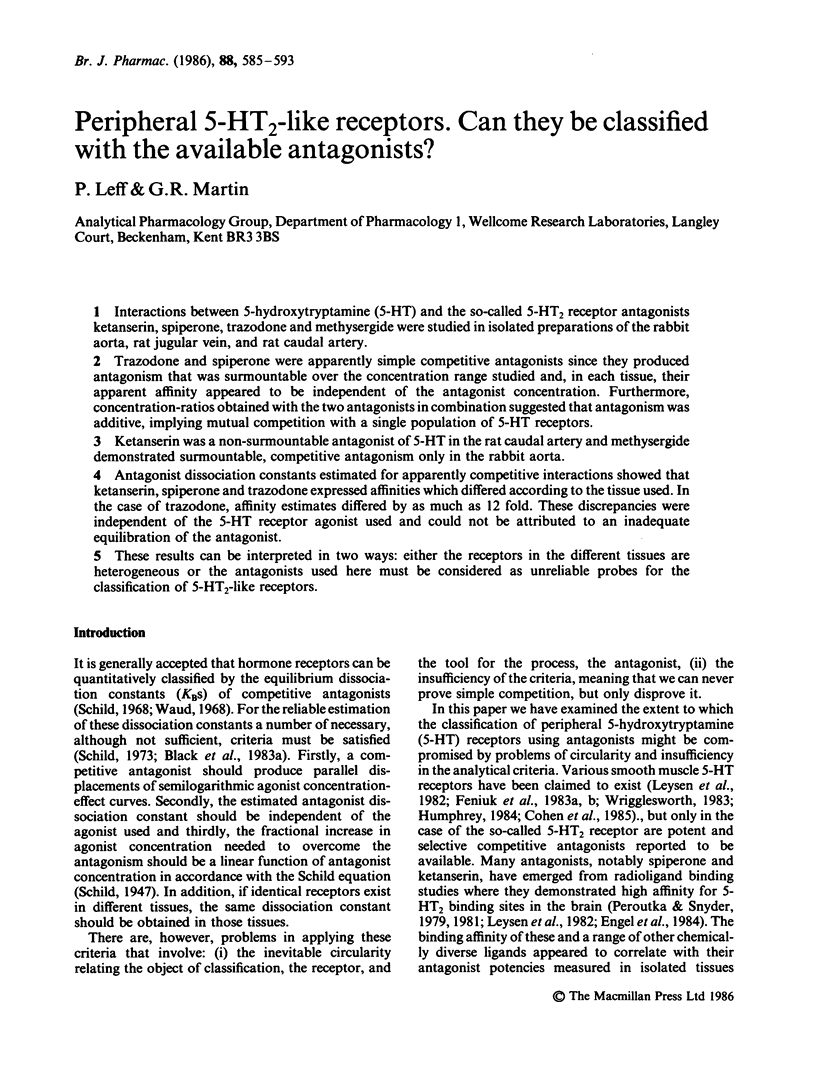
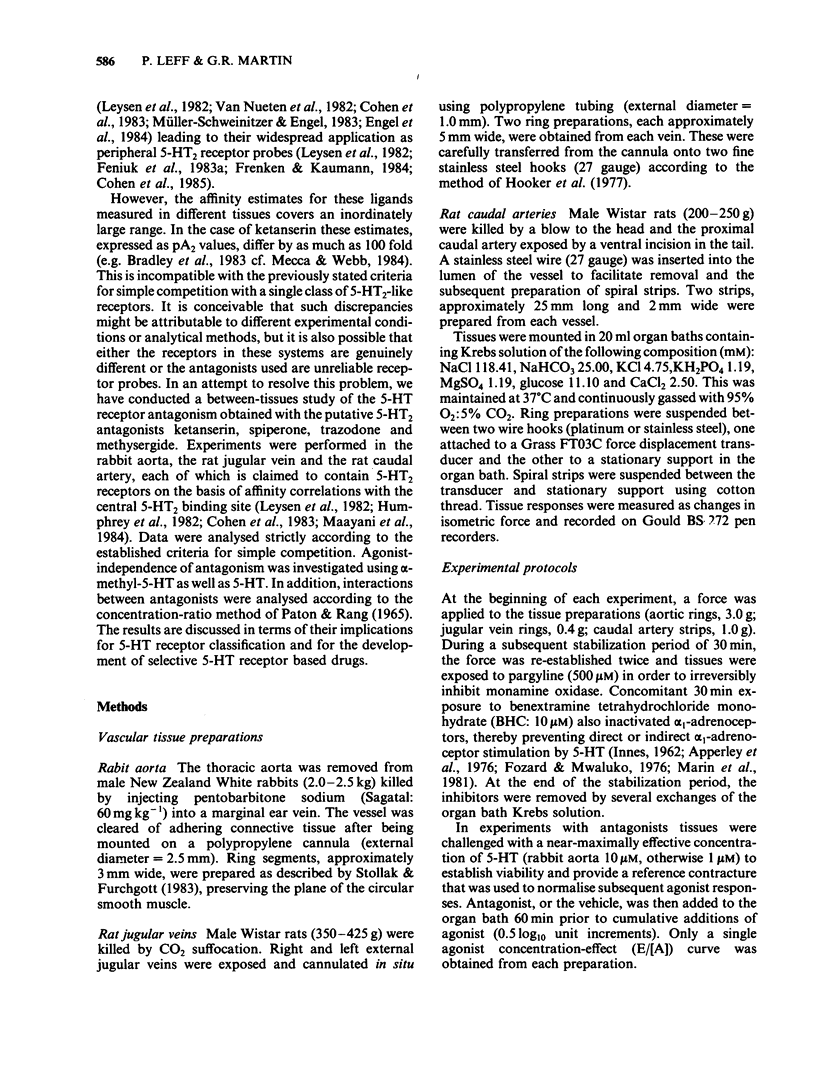
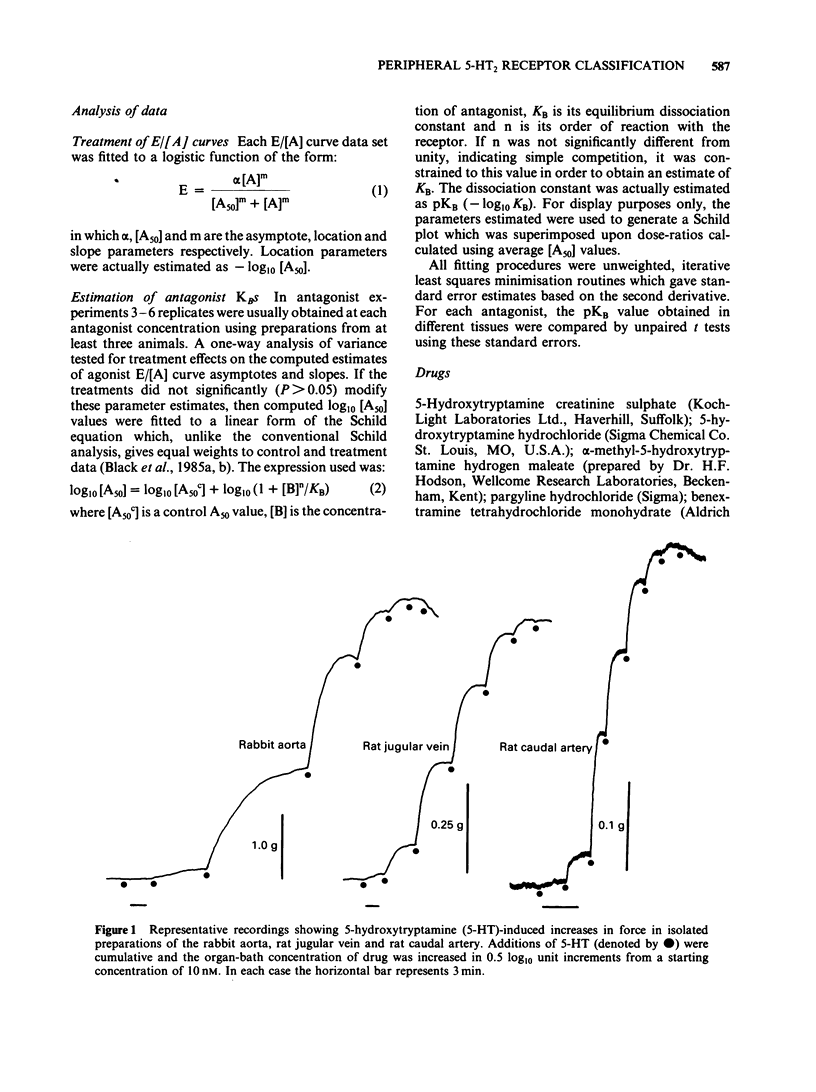
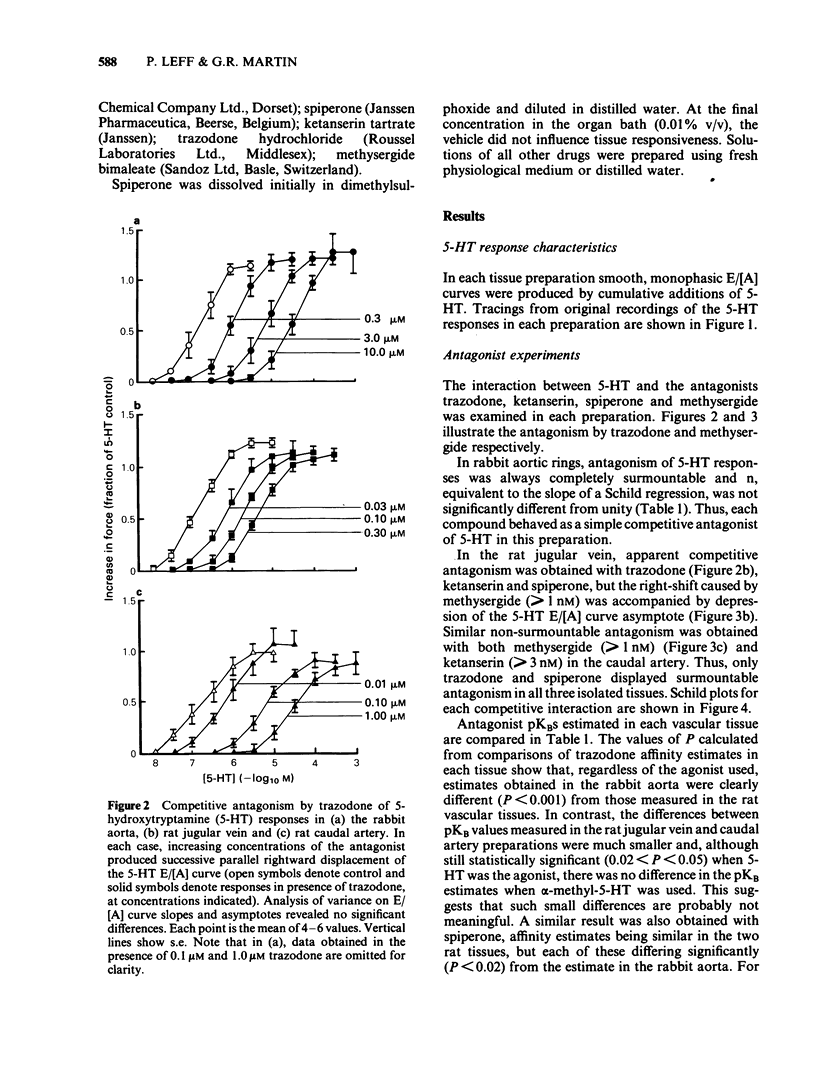
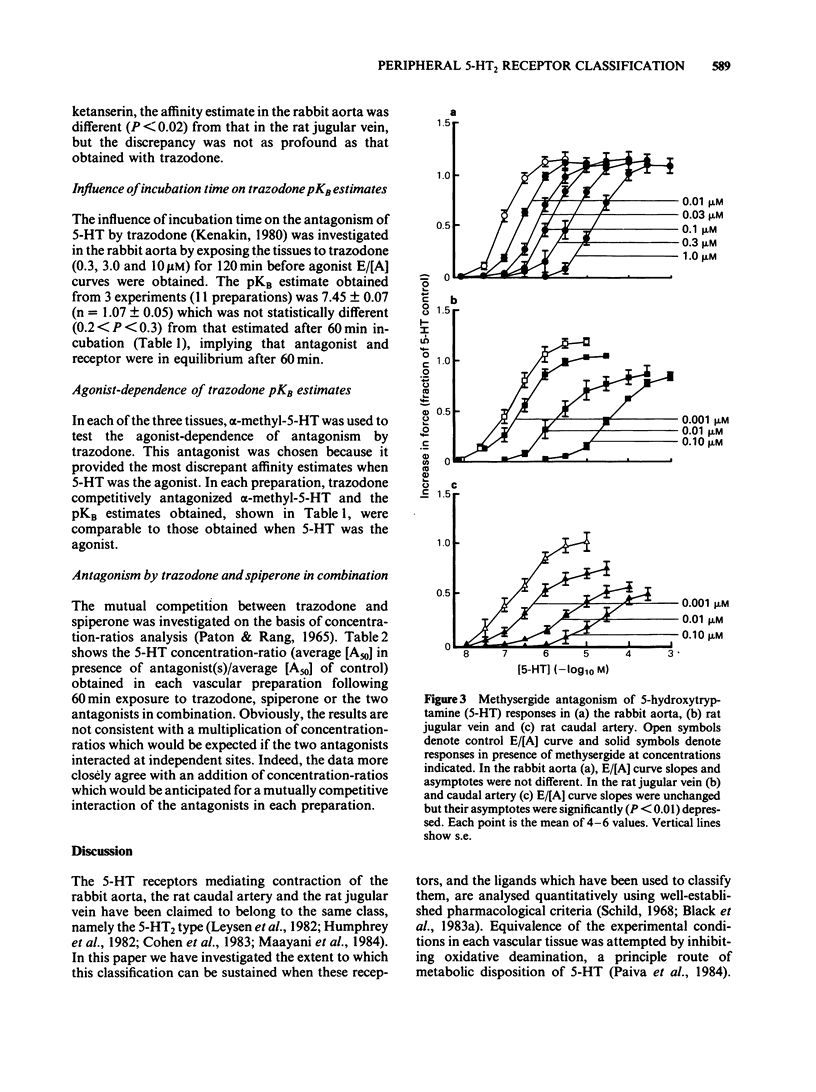
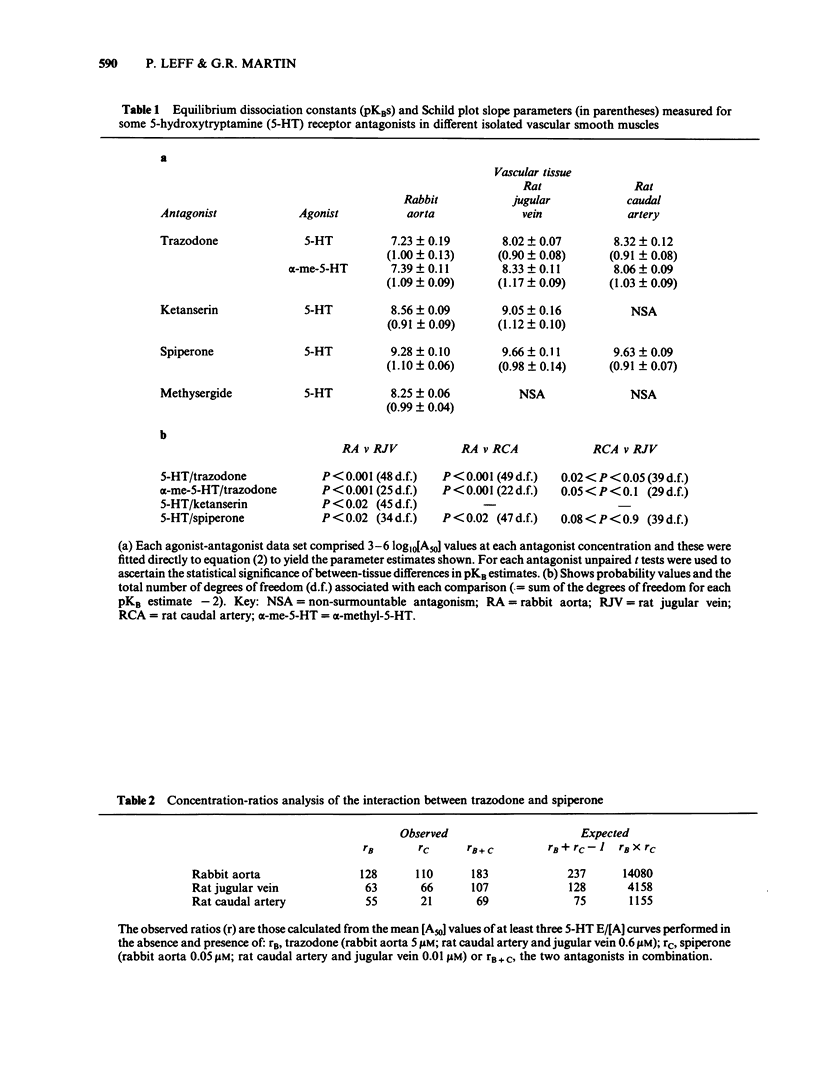
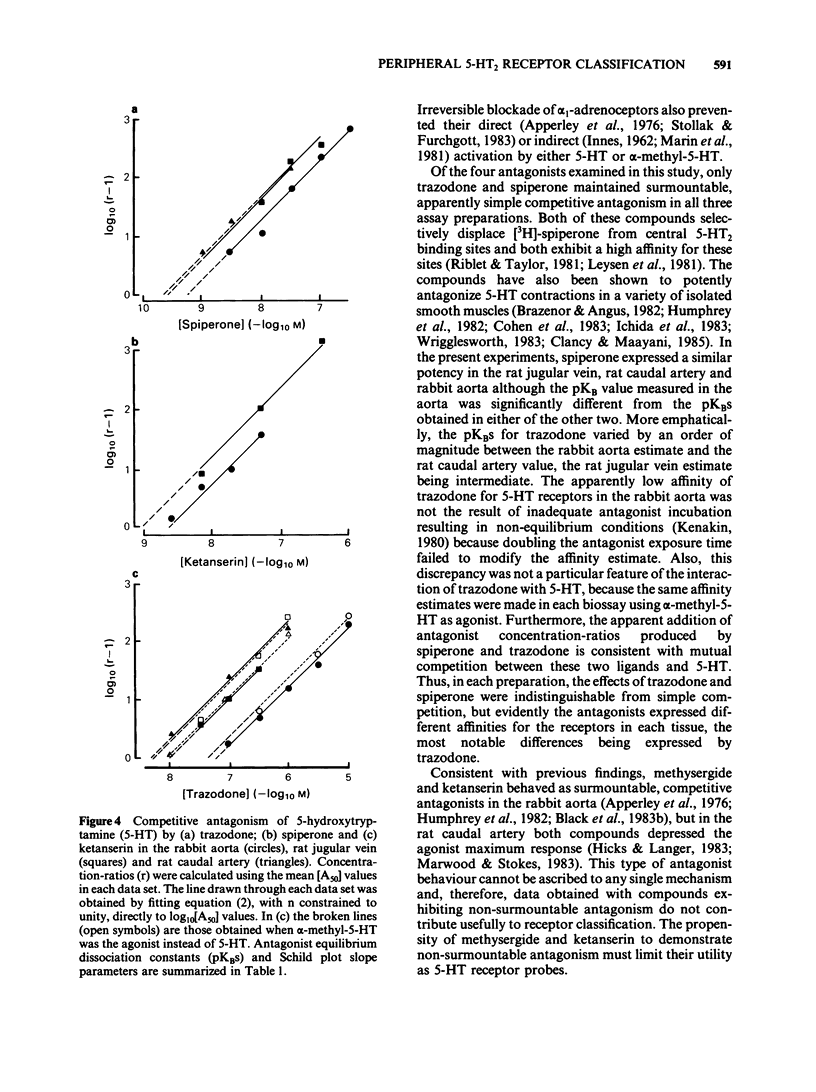
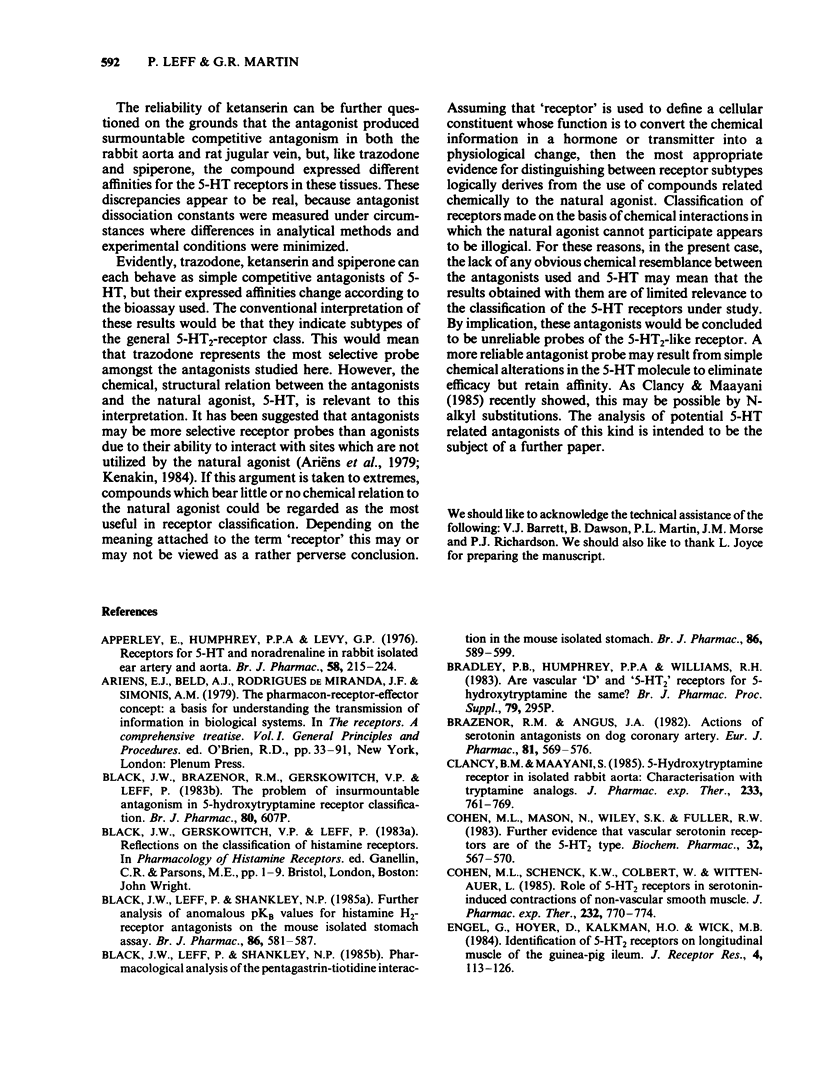
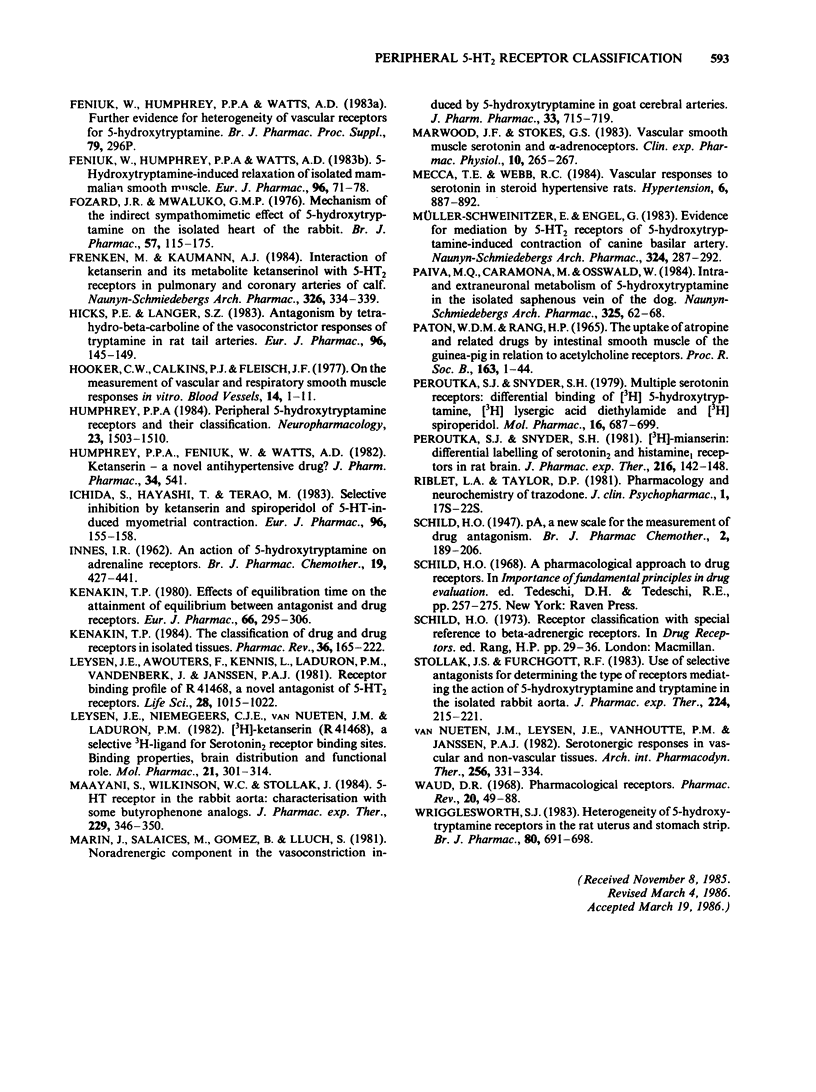
Selected References
These references are in PubMed. This may not be the complete list of references from this article.
- Black J. W., Leff P., Shankley N. P. Further analysis of anomalous pKB values for histamine H2-receptor antagonists on the mouse isolated stomach assay. Br J Pharmacol. 1985 Nov;86(3):581–587. doi: 10.1111/j.1476-5381.1985.tb08934.x. [DOI] [PMC free article] [PubMed] [Google Scholar]
- Black J. W., Leff P., Shankley N. P. Pharmacological analysis of the pentagastrin-tiotidine interaction in the mouse isolated stomach. Br J Pharmacol. 1985 Nov;86(3):589–599. doi: 10.1111/j.1476-5381.1985.tb08935.x. [DOI] [PMC free article] [PubMed] [Google Scholar]
- Brazenor R. M., Angus J. A. Actions of serotonin antagonists on dog coronary artery. Eur J Pharmacol. 1982 Jul 30;81(4):569–576. doi: 10.1016/0014-2999(82)90346-6. [DOI] [PubMed] [Google Scholar]
- Clancy B. M., Maayani S. 5-Hydroxytryptamine receptor in isolated rabbit aorta: characterization with tryptamine analogs. J Pharmacol Exp Ther. 1985 Jun;233(3):761–769. [PubMed] [Google Scholar]
- Cohen M. L., Mason N., Wiley K. S., Fuller R. W. Further evidence that vascular serotonin receptors are of the 5HT2 type. Biochem Pharmacol. 1983 Feb 1;32(3):567–570. doi: 10.1016/0006-2952(83)90541-5. [DOI] [PubMed] [Google Scholar]
- Cohen M. L., Schenck K. W., Colbert W., Wittenauer L. Role of 5-HT2 receptors in serotonin-induced contractions of nonvascular smooth muscle. J Pharmacol Exp Ther. 1985 Mar;232(3):770–774. [PubMed] [Google Scholar]
- Engel G., Hoyer D., Kalkman H. O., Wick M. B. Identification of 5HT2-receptors on longitudinal muscle of the guinea pig ileum. J Recept Res. 1984;4(1-6):113–126. doi: 10.3109/10799898409042543. [DOI] [PubMed] [Google Scholar]
- Feniuk W., Humphrey P. P., Watts A. D. 5-Hydroxytryptamine-induced relaxation of isolated mammalian smooth muscle. Eur J Pharmacol. 1983 Dec 9;96(1-2):71–78. doi: 10.1016/0014-2999(83)90530-7. [DOI] [PubMed] [Google Scholar]
- Fozard J. R., Mwaluko G. M. Mechanism of the indirect sympathomimetic effect of 5-hydroxytrypt-amine on the isolated heart of the rabbit. Br J Pharmacol. 1976 May;57(1):115–125. doi: 10.1111/j.1476-5381.1976.tb07661.x. [DOI] [PMC free article] [PubMed] [Google Scholar]
- Frenken M., Kaumann A. J. Interaction of ketanserin and its metabolite ketanserinol with 5HT2 receptors in pulmonary and coronary arteries of calf. Naunyn Schmiedebergs Arch Pharmacol. 1984 Jul;326(4):334–339. doi: 10.1007/BF00501438. [DOI] [PubMed] [Google Scholar]
- Hicks P. E., Langer S. Z. Antagonism by tetrahydro-beta-carboline of the vasoconstrictor responses to tryptamine in rat tail arteries. Eur J Pharmacol. 1983 Dec 9;96(1-2):145–149. doi: 10.1016/0014-2999(83)90543-5. [DOI] [PubMed] [Google Scholar]
- Hooker C. S., Calkins P. J., Fleisch J. H. On the measurement of vascular and respiratory smooth muscle responses in vitro. Blood Vessels. 1977;14(1):1–11. doi: 10.1159/000158110. [DOI] [PubMed] [Google Scholar]
- Humphrey P. P., Feniuk W., Watts A. D. Ketanserin--a novel antihypertensive drug? J Pharm Pharmacol. 1982 Aug;34(8):541–541. doi: 10.1111/j.2042-7158.1982.tb04788.x. [DOI] [PubMed] [Google Scholar]
- Humphrey P. P. Peripheral 5-hydroxytryptamine receptors and their classification. Neuropharmacology. 1984 Dec;23(12B):1503–1510. doi: 10.1016/0028-3908(84)90094-7. [DOI] [PubMed] [Google Scholar]
- INNES I. R. An action of 5-hydroxytryptamine on adrenaline receptors. Br J Pharmacol Chemother. 1962 Dec;19:427–441. doi: 10.1111/j.1476-5381.1962.tb01447.x. [DOI] [PMC free article] [PubMed] [Google Scholar]
- Ichida S., Hayashi T., Terao M. Selective inhibition by ketanserin and spiroperidol of 5-HT-induced myometrial contraction. Eur J Pharmacol. 1983 Dec 9;96(1-2):155–158. doi: 10.1016/0014-2999(83)90545-9. [DOI] [PubMed] [Google Scholar]
- Kenakin T. P. Effects of equilibration time on the attainment of equilibrium between antagonists and drug receptors. Eur J Pharmacol. 1980 Sep 5;66(4):295–306. doi: 10.1016/0014-2999(80)90462-8. [DOI] [PubMed] [Google Scholar]
- Kenakin T. P. The classification of drugs and drug receptors in isolated tissues. Pharmacol Rev. 1984 Sep;36(3):165–222. [PubMed] [Google Scholar]
- Leysen J. E., Awouters F., Kennis L., Laduron P. M., Vandenberk J., Janssen P. A. Receptor binding profile of R 41 468, a novel antagonist at 5-HT2 receptors. Life Sci. 1981 Mar 2;28(9):1015–1022. doi: 10.1016/0024-3205(81)90747-5. [DOI] [PubMed] [Google Scholar]
- Leysen J. E., Niemegeers C. J., Van Nueten J. M., Laduron P. M. [3H]Ketanserin (R 41 468), a selective 3H-ligand for serotonin2 receptor binding sites. Binding properties, brain distribution, and functional role. Mol Pharmacol. 1982 Mar;21(2):301–314. [PubMed] [Google Scholar]
- Maayani S., Wilkinson C. W., Stollak J. S. 5-Hydroxytryptamine receptor in rabbit aorta: characterization by butyrophenone analogs. J Pharmacol Exp Ther. 1984 May;229(2):346–350. [PubMed] [Google Scholar]
- Marin J., Salaices M., Gómez B., Lluch S. Noradrenergic component in the vasoconstriction induced by 5-hydroxytryptamine in goat cerebral arteries. J Pharm Pharmacol. 1981 Nov;33(11):715–719. doi: 10.1111/j.2042-7158.1981.tb13911.x. [DOI] [PubMed] [Google Scholar]
- Marwood J. F., Stokes G. S. Vascular smooth muscle serotonin and alpha-adrenoceptors. Clin Exp Pharmacol Physiol. 1983 May-Jun;10(3):265–267. doi: 10.1111/j.1440-1681.1983.tb00194.x. [DOI] [PubMed] [Google Scholar]
- Mecca T. E., Webb R. C. Vascular responses to serotonin in steroid hypertensive rats. Hypertension. 1984 Nov-Dec;6(6 Pt 1):887–892. doi: 10.1161/01.hyp.6.6.887. [DOI] [PubMed] [Google Scholar]
- Müller-Schweinitzer E., Engel G. Evidence for mediation by 5-HT2 receptors of 5-hydroxytryptamine-induced contraction of canine basilar artery. Naunyn Schmiedebergs Arch Pharmacol. 1983 Dec;324(4):287–292. doi: 10.1007/BF00502625. [DOI] [PubMed] [Google Scholar]
- PATON W. D., RANG H. P. THE UPTAKE OF ATROPINE AND RELATED DRUGS BY INTESTINAL SMOOTH MUSCLE OF THE GUINEA-PIG IN RELATION TO ACETYLCHOLINE RECEPTORS. Proc R Soc Lond B Biol Sci. 1965 Aug 24;163:1–44. doi: 10.1098/rspb.1965.0058. [DOI] [PubMed] [Google Scholar]
- Paiva M. Q., Caramona M., Osswald W. Intra- and extraneuronal metabolism of 5-hydroxytryptamine in the isolated saphenous vein of the dog. Naunyn Schmiedebergs Arch Pharmacol. 1984 Jan;325(1):62–68. doi: 10.1007/BF00507055. [DOI] [PubMed] [Google Scholar]
- Peroutka S. J., Snyder S. H. Multiple serotonin receptors: differential binding of [3H]5-hydroxytryptamine, [3H]lysergic acid diethylamide and [3H]spiroperidol. Mol Pharmacol. 1979 Nov;16(3):687–699. [PubMed] [Google Scholar]
- Peroutka S. J., Snyder S. H. [3H]Mianserin: differential labeling of serotonin and histamine receptors in rat brain. J Pharmacol Exp Ther. 1981 Jan;216(1):142–148. [PubMed] [Google Scholar]
- Stollak J. S., Furchgott R. F. Use of selective antagonists for determining the types of receptors mediating the actions of 5-hydroxytryptamine and tryptamine in the isolated rabbit aorta. J Pharmacol Exp Ther. 1983 Jan;224(1):215–221. [PubMed] [Google Scholar]
- Van Nueten J. M., Leysen J. E., Vanhoutte P. M., Janssen P. A. Serotonergic responses in vascular and non-vascular tissues. Arch Int Pharmacodyn Ther. 1982 Apr;256(2):331–334. [PubMed] [Google Scholar]
- Waud D. R. Pharmacological receptors. Pharmacol Rev. 1968 Jun;20(2):49–88. [PubMed] [Google Scholar]
- Wrigglesworth S. J. Heterogeneity of 5-hydroxytryptamine receptors in the rat uterus and stomach strip. Br J Pharmacol. 1983 Dec;80(4):691–697. doi: 10.1111/j.1476-5381.1983.tb10059.x. [DOI] [PMC free article] [PubMed] [Google Scholar]


